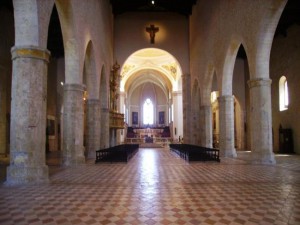The Basilica of Santa Maria di Collemaggio
“He who through cowardice made the great refusal …”. One can not but start from this verse of the Divine Comedy of great Dante Alighieri to describe the Basilica of Santa Maria di Collemaggio is located in L’Aquila.
Founded in 1288 precisely by behest of Pietro da Morrone, that Celestine V who renounced the papal throne and whose remains are kept in the Basilica itself.
Often damaged by numerous earthquakes (the last one in 2009).
Collemaggio is a mix of architectural styles due to frequent reconstructions.
The original version was replaced by the Baroque style following the disastrous earthquake of 1703, which destroyed the presbytery.
Baroque which was dismantled between 1969 and 1973 thanks to the intervention led by the then superintendent Mario Moretti, who brought the Basilica back to the original shape of Romanesque mold.
The tragic earthquake of 6 April 2009 has seriously damaged Santa Maria di Collemaggio, in particular in the area of the presbytery and the transept, while Celestine V Mausoleum remained almost intact.
Currently the Basilica is under reconstruction, the umpteenth of its long history.
 The access to it was enriched between late ‘800 and early’ 900 by a long tree-lined avenue leading to the basilica facade, considered the highest expression of Abruzzese architecture , decorated with two lateral rose windows and a central one (the main, authentic symbol of the city), and by three front doors, two side and one central: the latter is Gothic, while the other two are neo-Romanesque.
The access to it was enriched between late ‘800 and early’ 900 by a long tree-lined avenue leading to the basilica facade, considered the highest expression of Abruzzese architecture , decorated with two lateral rose windows and a central one (the main, authentic symbol of the city), and by three front doors, two side and one central: the latter is Gothic, while the other two are neo-Romanesque.
On the left wall we find instead the Holy Door, emblem of Aquila Jubilee better known as Perdonanza (in the evening of August 28 and that of 29), which allows to obtain a plenary indulgence to the devotees who cross it.
The interior, as mentioned, has returned recently in Romanesque style, with a wooden ceiling and three naves, of which the right one is wider than the left one, with the addition of a Gothic choir.
Collemaggio church has always been shrouded in mystery.
Inside you can find many symbolic references about the Templars (the rancor of Celestine V with the Church of Rome would derive precisely from its relationship with the Templars).
Not by chance many claim that the Holy Grail can be found right in these walls, buried or well hidden in some nook of the Basilica.

